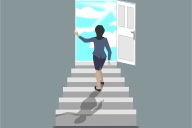You have /5 articles left.
Sign up for a free account or log in.

VectorKIF/istock/getty images plus
Anyone who has been teaching during COVID-19 knows that everything has been 12 times harder. Our students are still struggling. Our colleagues are burned out. Teaching on Zoom has been intense and exhausting in ways we never expected.
But I have found four pandemic-inspired classroom strategies that I love and plan to keep when we are back together face-to-face this coming fall. Maybe you can use them when this is all over, too.
No. 1: A precourse digital student survey. I have always surveyed my students on the first day of class, handing out note cards and asking them to tell me why they signed up for the course and what they hope to get out of it. In the switch to virtual teaching, I sent out a digital survey before the first day of the semester. I asked pandemic-related questions that I hope to never use again, such as “What time zone are you in?” and “How’s your internet connection?” But others I will keep, including, “What else would you like to tell me about your situation that will help me to best accommodate you? Are you commuting, working full-time, parenting? Any other challenges that I should know about?”
The survey is also a great way to solicit affirmed names and pronouns without students having to disclose anything in front of the class on the first day, allowing the instructor to create a more inclusive, comfortable and welcoming space for everyone from the very start. From these surveys, I learned just how many of my students were struggling during the pandemic, and they shared far more in this format than they ever did on the old note cards -- particularly about what they needed to support their learning. I also really liked having a way to get to know the students a little better before the semester began so I could make some adjustments to the course. To conduct the survey, I used a tool built into our learning management system, although a Google survey would work just as well.
No. 2: Setting the scene. I am accustomed to arriving early to class and having a few minutes of conversation with students to get to know them and to ease the transition into formal class time. On Zoom, I found we were all coming into class with our minds racing, distracted, full of anxiety -- turning on cameras at the very last second, if at all. To help get our heads into the learning space, I borrowed a tried-and-true technique from pre-COVID teachers: each class period I asked one or two students to “set the scene” by sharing a snippet of music, a short poem or a piece of art.
Students briefly explained how the piece related to the content of our class and why they chose it. It was lovely to start class with a minute or two of art, and it gave students a way to connect the themes of our course with other disciplines and genres they care about. Not only did the exercise get everyone focused and ready to work together, it also served as a wonderful way to build community: the students frequently used the chat to discuss what was shared. One day, they were so inspired by the music that one of their peers had selected that they co-created a five-hour-long Spotify list of songs related to the course.
No. 3: Group work with Google slides. Before class I would create a slide deck, sometimes with a different primary document for each group to analyze or discussion questions for a reading. I could give the students the link to the shared document, send them all into breakout rooms and then monitor their progress as they typed their responses to the questions onto the slides. It gave me a much better sense of when the groups were wrapping up, and I could also see who was struggling and with what question. The shared slides made reporting back to the full class much more enjoyable for everyone, and I had an artifact of their thinking and learning for assessment purposes. Since our students all have university-issued laptops, I plan to keep using shared slides when we are in class in person, and it will be easy to project their work on the screen in the front of the classroom.
No. 4: Self-assessment for class participation grade. For my classes, students tend to learn the most when they do the reading, spend some time reflecting and writing, and come to class ready to participate in discussions. I usually grade attendance and class participation as a single score on a simple three-point scale for every class period. I also prefer lots of low-stakes, small grades that encourage consistent workflow, sustained learning and regular engagement with course material -- as opposed to just a few large assignments.
I have long used a rubric to alleviate some of the issues with implicit bias inherent in class participation grades, but I still had concerns that were amplified with Zoom teaching when so many students were not turning on cameras or were reluctant to speak. Just the act of having to unmute was often enough to keep many students quiet. Others were willing to participate in the chat but not in the group discussion. And I had no way of knowing what individual participation looked like when students were in breakout rooms.
I discovered my absolute favorite COVID-inspired strategy was letting students grade themselves. I used the same low-stakes, three-point scale and developed a new self-assessment rubric that I had students complete after every class session:
Using the self-assessment rubric, score your participation today from 1 to 3 (and explain why):
- I attended, but my head wasn’t in it or I didn’t prepare. I didn’t speak or participate in the chat.
- I offered some comments and stayed engaged, but I know I could do even more.
- I had prompt attendance, I was thoroughly prepared and engaged, and I offered comments and ideas that transformed the way everyone else in the class understood the material and moved our collective learning forward.
Students also briefly answered a question related to the day’s content. That prompt let them express questions they still had, which I could then address at the beginning of the next class (like a traditional “muddiest point” exercise). I could also see what was inspiring them to think more deeply and any connections they were making between readings and discussions. The responses were truly fun to read and invaluable in helping me shape the course throughout the semester.
But the best part of this assignment was students’ self-reflection on their own learning. The regular checking in about not only what they learned but also how they learned and could do better pushed this exercise to the meta-cognitive level, where students were thinking about their own thinking.
At first I worried that students would simply take the easy path and give themselves all 3s. But I saw enough 1s and 2s to sense that they were being very honest, and students often included comments such as, “I give myself a 1: I did the reading for class today but was unfocused.”
Most important, students consistently used the opportunity to think about how they could improve, such as, “I learned that I am doing the readings, but I just may not be retaining a lot of the details. It may help for me to go through the reading once, and then a day or so later, go back and skim through so that I reinforce the details in my head.” Or, “Although I read the readings, I didn’t engage with them very much, which meant I didn’t participate in the class discussion as much as I could have.” Students recognized both positives and growth areas: “I give myself a 2. I participated a good bit in the breakout rooms, but I feel like I could have given more input. I did utilize the chat more, which I think helped to engage conversation!”
The self-assessment also allowed students to take more ownership of classroom dynamics. For example: “I think I did a good job paying attention and staying engaged, but I could have done a better job at offering space for people to disagree or have a different perspective in the breakout rooms.” Students realized they were responsible for our collective learning with statements such as, “I give myself a 2, because I offered my feedback in the breakout groups … I have noticed that I do not speak up because I am more about listening to other people’s perspectives and seeing if I can bounce any ideas off of them … so I will work on that as well.”
Crucially, the self-assessment revealed what real effort and participation looked like to the student, especially in the context of their complicated lives. For example, “I would give myself a 2 today. I was having a rough day and didn’t speak up as much as I could have. I did read the texts and come to class prepared, though.” Another student explained, “I give myself a 3. I still managed to take part in class, and the breakout groups, even though I was babysitting my niece.” Similarly, a student responded, “For participation today, I give myself a 3, because although I’ve been in the hospital and now am home recovering, I still participated and shared my ideas in the chat and breakout rooms, as well as in the main Zoom.” Without the self-assessment, I would never have known these students’ circumstances.
Some faculty have students do self-assessments on paper. But I plan to keep this teaching strategy online, along with the other three, even after we move back to our (hopefully) post-pandemic, in-person classrooms this fall.








